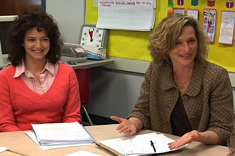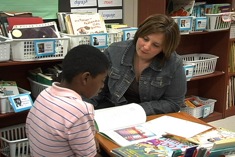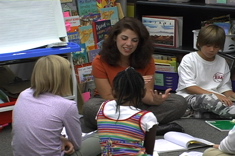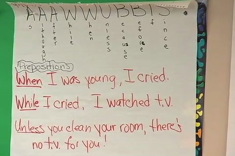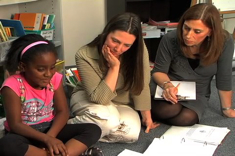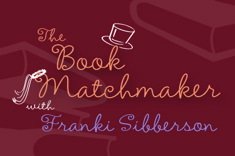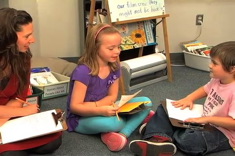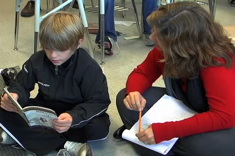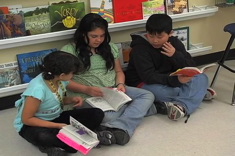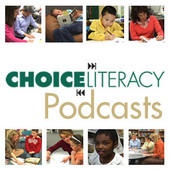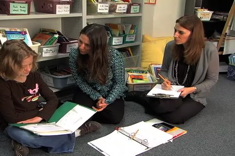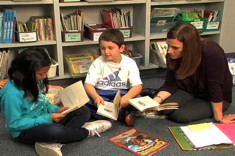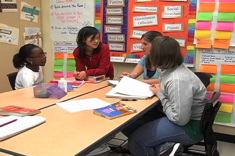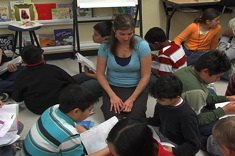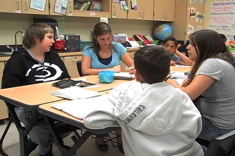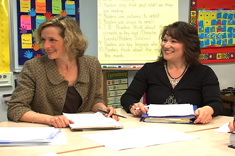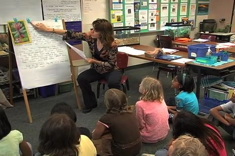Library
Choice Literacy Articles & Videos
The Choice Literacy library contains over 3,000 articles and 900 videos from 150+ contributors. Classic Classroom and Literacy Leadership subscribers have access to the entire library. Content is updated continuously, with five to six new features published each week.
Latest Content
Professional Development Closing Activities (ROUND-UP)
This round-up is on professional development closing activities includes contributions from Jennifer Allen, Aimee Buckner, and Heather Rader.
Quick Take: “The Sisters” on Writing Journals
In this two-minute Quick Take video, Gail Boushey and Joan Moser (“The Sisters”) talk about the importance of having “Small Moments” and “Happenings” sections in student writing journals.
Next-Read Stack: Conferring for Independence
Franki Sibberson explains the value of "Next-Read Stack" conferences for fostering independence, and includes a video example.
Sixth-Grade Lesson: Editing for Conventions
In this lesson with her sixth graders, Pam Pogson talks about a goal many students have mentioned during writing conferences: editing for conventions. This brief lesson gives everyone a chance to brainstorm common errors and fixes.
The Five-Minute Solution: Mini-Groups after Minilessons to Maximize Conferring Time
Aimee’ Buckner’s mini-groups are an easy and simple way to differentiate instruction in workshops, and save time when conferring.
Extreme Makeover: Revision Edition
Heather Rader finds short text and shared modeling of revision strategies are just the scaffolds students need to see the power of revision for improving writing.
Over the Top: Mystery Writing with Fourth Graders
Helping students navigate the boundaries between realistic fiction and fantasy can be tricky, especially when it comes to mystery writing. In this lesson from Beth Lawson’s fourth-grade classroom, Beth uses a top hat graphic to help students think through when writing is “over the top” in mysteries.
Getting Started with Sentence Observations
Karen Terlecky details the assessments and preparation that goes into the design of her sentence observation program.
What to Say on Parent Teacher Night
Clare Landrigan and Tammy Mulligan present some of the anecdotes and research they would share with parents during open houses and conferences.
Listen In: Maya is a Chapter Writer
Some young writers take a lot of time and encouragement on the journey to uninhibited prose, while others zip to prolific. Maya is such a writer. Heather Rader assists this proficient 2nd grade writer as her teacher observes.
Connecting Read Alouds and the Literacy Curriculum at the Start of the School Year
Here are some ways to link read alouds with learning across the curriculum at the start of the year, suggested by Choice Literacy readers.
Book Matchmaker: Texts for Young English Language Learners
Franki Sibberson shares some of her favorite new titles for young English language learners.
Exit Slips Open Doors
Amanda Adrian explains how a simple professional development closure activity garnered many new invitations to classrooms.
Literacy Groundings
Andie works with new teachers as they share their literacy groundings — the moments in their histories that shaped who they are as educators.
Stop and Track: Conferring with a Fifth-Grade Reader
In this conference with a 5th grader, Aimee Buckner shares two strategies — one to use when putting a book away between readings, and another to help keep track of characters in a complex narrative where the point of view is constantly shifting.
Fresh Books and Age-old Skills
Suzy Kaback provides a booklist of newer texts that can be used to teach multiple reading strategies.
Middle School Book Clubs: Introduction
Katie Doherty explains why she has book clubs with her 6th grade students.
Fluency in Focus: Conferring with Jake
Gail Boushey confers with Jake, a seven-year-old who is setting a reading goal of developing fluency. After the conference, she debriefs with Joan Moser.
Literacy Coaching and Student Work with Diane Sweeney (PODCAST)
Diane Sweeney talks about the importance of focusing more on student work and less on teacher plans and lessons for literacy coaches.
Listen In: Knowing When You’re Done
When is writing finished? Heather Rader confers with a second grader over that age-old question for writers as Linda Karamatic listens in.
Guiding Reading Partners: Work on Accuracy
In this reading conference from a 2nd grade classroom, Linda Karamatic pairs two children who have similar needs in reading.
Middle School Book Clubs: Response Options
Students have different response options in Katie Doherty’s sixth grade book clubs.
Every. Single. Day.
Ruth Shagoury listens in as Katie Doherty's students give advice to a new classmate, and in the process reveal the norms and expectations for reading and writing workshops.
“And Then and Then and Then”: Moving Students from Retelling to Thoughtful Response
Katie Doherty confers with sixth grader Kristina during reading workshop. Kristina is new to the classroom, and Katie demonstrates how to gently move a student from retelling to more thoughtful responses to literature with a few simple and carefully worded questions.
Middle School Book Clubs in Action
Katie Doherty talks about the links between strategy lessons and book club work in her 6th grade classroom. Katie also sits in on a book club discussion.
Telling Our Stories
Ruth Shagoury and Andie Cunningham beautifully weave together poetry and storytelling in a potent professional development activity for teachers.
The Power of Powerpoints for English Language Learners
Erin Ocon discovers a surprising tool to help her middle school English language learners develop their writing and oral language skills — Powerpoint presentations. Erin shares some practical tips for using presentation software to support English language learners.
Vocabulary, Comprehension, and the Common Core: A Conversation with Doug Fisher (PODCAST)
In this podcast, Doug Fisher discusses how vocabulary fits into the Common Core State Standards.
Listen In: XBox Game Writing
Boys and their toys: Heather Rader confers with a second grader over his game writing while Linda Karamatic listens in.
Frogs as Learning Ambassadors Part 1: Literary Nonfiction in 4th Grade
Andrea Smith gets creative in teaching literary nonfiction to her 4th graders in this video series.
Browse Content By
Type
Category
- Assessment Tools
- Big Fresh Archives
- Booklists
- Choice Numeracy
- Classroom Design
- Common Core
- Community Building
- Conferring
- Content Literacy
- Digital Literacy
- English Language Learners
- Equity
- Family Relations
- Free Samples
- Guiding Groups
- Leadership
- Literacy Coaches
- Mentor Texts
- Minilessons
- New Teacher Mentors
- Podcasts
- Poetry
- Quote Collections
- Reading Strategies
- Self Care
- Struggling and Striving Learners
- Talking and Listening
- Teacher Study Groups
- Teaching Reading
- Teaching Writing
- Word Study and Vocabulary
Author
- Melissa Quimby
- Nawal Qarooni
- Gwen Blumberg
- Julie Cox
- The Lead Learners
- Hannah Tills
- Josie Stewart
- Ruth Metcalfe
- Mallory Messenger
- Becca Burk
- Jodie Bailey
- Vivian Chen
- Mary Brower
- Tiffany Abbott Fuller
- Stephanie Affinito
- Ruth Ayres
- Leigh Anne Eck
- Heather Fisher
- Shari Frost
- Julie Johnson
- Suzy Kaback
- Gigi McAllister
- Shirl McPhillips
- Melanie Meehan
- Cathy Mere
- Debbie Miller
- Tara Barnett and Kate Mills
- Tammy Mulligan
- Dana Murphy
- Bitsy Parks
- David Pittman
- Brenda Power
- Heather Rader
- Matt Renwick
- Mandy Robek
- Christy Rush-Levine
- Gretchen Schroeder
- Jen Schwanke
- Brian Sepe
- Katherine Sokolowski
- Stella Villalba
- Jennifer Vincent
Grade Level
Choice Literacy Membership
Articles
Get full access to all Choice Literacy article content
Videos
Get full access to all Choice Literacy video content
Courses
Access Choice Literacy course curriculum and training

